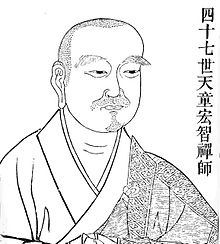Hongzhi Zhengjue
| Hongzhi Zhengjue |
|
|---|---|
 |
|
| Religion | Chan |
| Personal | |
| Born | 1091 Xizhoue, China |
| Died | 1157 |
| Senior posting | |
| Title | Chan master |
| Predecessor | Danxia Zichun |
| Religious career | |
| Teacher | Danxia Zichun |
Hongzhi Zhengjue (Chinese: 宏智正覺; pinyin: Hóngzhì Zhēngjué; Wade–Giles: Hung-chih Cheng-chueh, Japanese: Wanshi Shōgaku), also sometimes called Tiantong Zhengjue (Chinese: 天童正覺; Japanese: Tendo Shōgaku) (1091–1157), was a Chinese Chan (Japanese: Zen) Buddhist monk who authored or compiled several influential Buddhist texts. Hongzhi's conception of silent illumination is of particular importance to the Chinese Caodong Chan and Japanese Sōtō Zen schools; however, Hongzhi was also the author of an important collection of kōans, although kōans are now usually associated with the Chinese Linji or Japanese Rinzai schools.
According to the account given in Taigen Dan Leighton's Cultivating the Empty Field, Hongzhi was born to a family named Li in Xizhou, present-day Shanxi province. He left home at the age of eleven to become a monk, studying under Caodong master Kumu Faqeng, among others, including Yuanwu Keqin, author of the famous kōan collection, the Blue Cliff Record.
In 1129, Hongzhi began teaching at the Jingde monastery on Mount Tiantong, where he remained for nearly thirty years, until shortly before his death in 1157, when he ventured down the mountain to bid farewell to his supporters.
...
Wikipedia
